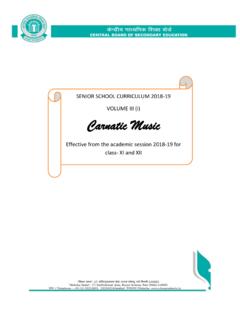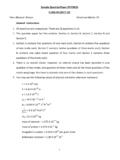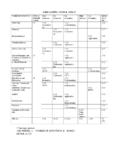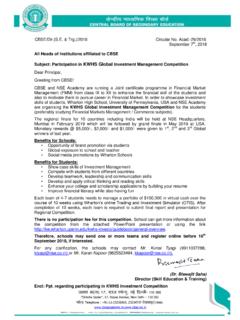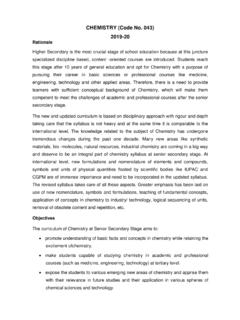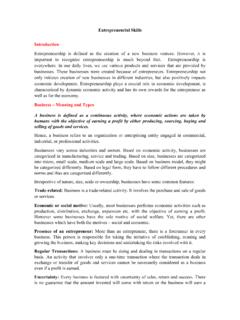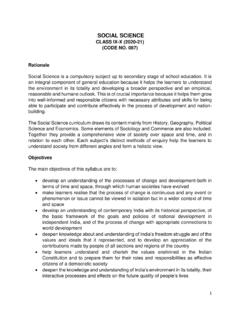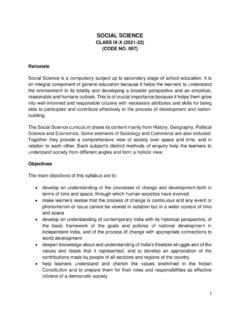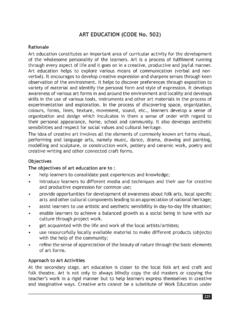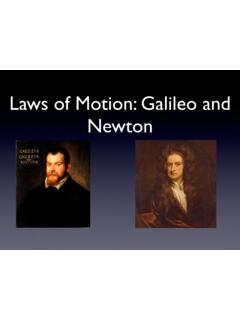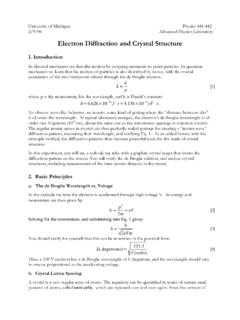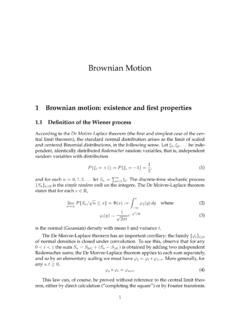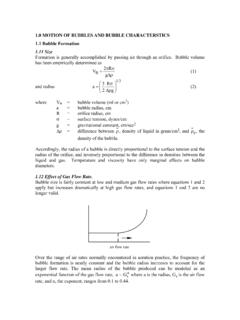Transcription of PHYSICS XI (Code No. 042) COURSE STRUCTURE Class XI ...
1 PHYSICS XI (Code No. 042) COURSE STRUCTURE Class XI (Theory) Term 1 Time: one and half hours. Max Marks: 35 No. of Periods Marks Unit I Physical World and Measurement 6 20 Chapter 1: Physical World Chapter 2: Units and Measurements Unit-II Kinematics 16 Chapter 3: motion in a Straight Line Chapter 4: motion in a Plane Unit III Laws of motion 10 Chapter 5: Laws of motion Unit IV Work, Energy and Power 12 15 Chapter 6: Work, Energy and Power Unit V motion of System of Particles and Rigid Body 16 Chapter 7: System of Particles and Rotational motion Unit-VI Gravitation 8 Chapter 8: Gravitation Total 68 35 Syllabus assigned for first term Unit I: Physical World and Measurement 6 Periods Chapter 1: Physical World PHYSICS -scope and excitement; nature of physical laws; PHYSICS , technology and society.
2 (To be discussed as a part of Introduction and integrated with other topics) Chapter 2: Units and Measurements Need for measurement: Units of measurement; systems of units; SI units, fundamental and derived units. Length, mass and time measurements; accuracy and precision of measuring instruments; errors in measurement; significant figures. Dimensions of physical quantities, dimensional analysis and its applications. Unit II: Kinematics 16 Periods Chapter 3: motion in a Straight Line Elementary concepts of differentiation and integration for describing motion , uniform and non- uniform motion , average speed and instantaneous velocity, uniformly accelerated motion , velocity - time and position-time graphs. Relations for uniformly accelerated motion (graphical treatment).
3 Chapter 4: motion in a Plane Scalar and vector quantities; position and displacement vectors, general vectors and their notations; equality of vectors, multiplication of vectors by a real number; addition and subtraction of vectors, relative velocity, Unit vector; resolution of a vector in a plane, rectangular components, Scalar and Vector product of vectors. motion in a plane, cases of uniform velocity and uniform acceleration-projectile motion , uniform circular motion . Unit III: Laws of motion 10 Periods Chapter 5: Laws of motion Intuitive concept of force, Inertia, Newton's first law of motion ; momentum and Newton's second law of motion ; impulse; Newton's third law of motion . (Recapitulation only) Law of conservation of linear momentum and its applications.
4 Equilibrium of concurrent forces, Static and kinetic friction, laws of friction, rolling friction, lubrication. Dynamics of uniform circular motion : Centripetal force, examples of circular motion (vehicle on a level circular road, vehicle on a banked road). Unit IV: Work, Energy and Power 12 Periods Chapter 6: Work, Energy and Power Work done by a constant force and a variable force; kinetic energy, work-energy theorem, power. Notion of potential energy, potential energy of a spring, conservative forces: conservation of mechanical energy (kinetic and potential energies); non-conservative forces: motion in a vertical circle; elastic and inelastic collisions in one and two dimensions. Unit V: motion of System of Particles and Rigid Body 16 Periods Chapter 7: System of Particles and Rotational motion Centre of mass of a two-particle system, momentum conservation and centre of mass motion .
5 Centre of mass of a rigid body; centre of mass of a uniform rod. Moment of a force, torque, angular momentum, law of conservation of angular momentum and its applications. Equilibrium of rigid bodies, rigid body rotation and equations of rotational motion , comparison of linear and rotational motions. Moment of inertia, radius of gyration, values of moments of inertia for simple geometrical objects (no derivation). Unit VI: Gravitation 8 Periods Chapter 8: Gravitation Universal law of gravitation. Acceleration due to gravity (recapitulation only) and its variation with altitude and depth. Gravitational potential energy and gravitational potential, escape velocity, orbital velocity of a satellite, Geo-stationary satellites.
6 Class XI (Theory) Term II Time: 2hrs Max Marks: 35 Unit Periods Marks Unit VII Properties of Bulk Matter 22 23 Chapter 9: Mechanical Properties of Solids Chapter 10: Mechanical Properties of Fluids Chapter 11: Thermal Properties of Matter Unit VIII Thermodynamics 10 Chapter 12: Thermodynamics Unit IX Behaviour of Perfect Gases and Kinetic Theory of Gases 08 Chapter 13: Kinetic Theory Unit X Oscillations and Waves 23 12 Chapter 14: Oscillations Chapter 15: Waves Total Marks 63 35 Syllabus assigned for Term II Unit VII: Properties of Bulk Matter 22 Periods Chapter 9: Mechanical Properties of Solids Stress-strain relationship, Hooke's law, Young's modulus, bulk modulus Chapter 10: Mechanical Properties of Fluids Pressure due to a fluid column; Pascal's law and its applications (hydraulic lift and hydraulic brakes), effect of gravity on fluid pressure.
7 Viscosity, Stokes' law, terminal velocity, streamline and turbulent flow, critical velocity, Bernoulli's theorem and its applications. Surface energy and surface tension, angle of contact, excess of pressure across a curved surface, application of surface tension ideas to drops, bubbles and capillary rise. Chapter 11: Thermal Properties of Matter Heat, temperature, (recapitulation only) thermal expansion; thermal expansion of solids, liquids and gases, anomalous expansion of water; specific heat capacity; Cp, Cv - calorimetry; change of state - latent heat capacity. Heat transfer-conduction, convection and radiation (recapitulation only), thermal conductivity, qualitative ideas of Blackbody radiation, Wein's displacement Law, Stefan's law, Greenhouse effect. Unit VIII: Thermodynamics 10 Periods Chapter 12: Thermodynamics Thermal equilibrium and definition of temperature (zeroth law of thermodynamics), heat, work and internal energy.
8 First law of thermodynamics, isothermal and adiabatic processes. Second law of thermodynamics: reversible and irreversible processes Unit IX: Behaviour of Perfect Gases and Kinetic Theory of Gases 08 Periods Chapter 13: Kinetic Theory Equation of state of a perfect gas, work done in compressing a gas. Kinetic theory of gases - assumptions, concept of pressure. Kinetic interpretation of temperature; rms speed of gas molecules; degrees of freedom, law of equi-partition of energy (statement only) and application to specific heat capacities of gases; concept of mean free path, Avogadro's number. Unit X: Oscillations and Waves 23 Periods Chapter 14: Oscillations Periodic motion - time period, frequency, displacement as a function of time, periodic functions.
9 Simple harmonic motion ( ) and its equation; phase; oscillations of a loaded spring- restoring force and force constant; energy in Kinetic and potential energies; simple pendulum derivation of expression for its time period. Free, forced and damped oscillations (qualitative ideas only), resonance. Chapter 15: Waves Wave motion : Transverse and longitudinal waves, speed of travelling wave, displacement relation for a progressive wave, principle of superposition of waves, reflection of waves, standing waves in strings and organ pipes, Beats PRACTICALS Syllabus for TERM I Total Periods: 16 The record, to be submitted by the students, at the time of their First term examination, has to include: Record of at least 4 Experiments, to be performed by the students Record of at least 3 Activities [with 3 each from section A and section B], to be demonstrated by teacher.
10 Time Allowed: O n e and h al f hours Max. Marks: 30 Two experiments one from each section 8 Marks Practical record (experiment and activities) 2 Marks Viva on experiments, and activities 5 Marks Total 15 Marks Syllabus assigned for Practical Term I Experiments 1. To measure diameter of a small spherical/cylindrical body and to measure internal diameter and depth of a given beaker/calorimeter using Vernier Calipers and hence find its volume. 2. To measure diameter of a given wire and thickness of a given sheet using screw gauge. OR To determine volume of an irregular lamina using screw gauge. 3. To determine radius of curvature of a given spherical surface by a spherometer. 4. To determine the mass of two different objects using a beam balance. 5. To find the weight of a given body using parallelogram law of vectors.
